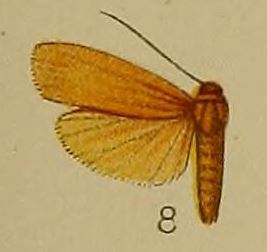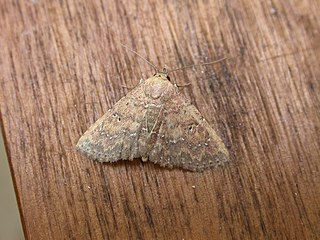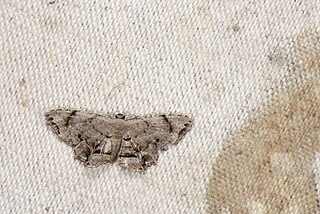
Utetheisa pulchelloides, the heliotrope moth, is a moth of the family Erebidae. It is found in the Indo-Australian region including Borneo, Hong Kong, New Zealand, Papua, Seychelles, most of Australia,Tenerife and La Línea de la Concepción [Cádiz]. The species was first described by George Hampson in 1907.
Coptobasis is a genus of moths of the family Crambidae.

Pilocrocis is a genus of moths of the family Crambidae. The genus was first erected by Julius Lederer in 1863.
Oxygonitis is a monotypic moth genus of the family Noctuidae. Its single species, Oxygonitis sericeata, is found in the Indian subregion, Myanmar, Sumatra, Peninsular Malaysia, Java, Borneo, the Philippines, Sulawesi, Australia and Sri Lanka. Both the genus and species were first described by George Hampson in 1893.

Tathorhynchus is a monotypic moth genus in the family Erebidae erected by George Hampson in 1894. Its only species, Tathorhynchus exsiccata, the Levant blackneck or double-spotted snout, was first described by Julius Lederer in 1855. The nominate form is found on the Canary Islands and in North Africa, tropical Asia and tropical Africa. It has been introduced in Dominica and Argentina. Subspecies Tathorhynchus exsiccata fallax is found in the northern half of Australia, as well as Norfolk Island and New Zealand.
Pomasia is a genus of moths in the family Geometridae.
Spectroreta is a monotypic moth genus belonging to subfamily Drepaninae erected by Warren in 1903. Its only species, Spectroreta hyalodisca, was described by George Hampson in 1896.

Brunia antica is a moth of the family Erebidae described by Francis Walker in 1854. It is found from the Indian subregion, Sri Lanka to China, the Ryukyu Islands, the Chagos Archipelago, the Nicobar Islands and Sundaland.

Cerynea trogobasis is a species of moth of the family Erebidae first described by George Hampson in 1910. It is found in Queensland in Australia and the Kai Islands of Indonesia.
Gymnoscelis imparatalis, the flower-looper moth, is a moth in the family Geometridae. It is found from the Indo-Australian tropics of India, Sri Lanka, east to the Society Islands and the Marquesas Archipelago. The habitat consists of both lowland and montane ecosystems.

Manoba major is a moth in the family Nolidae. It was described by George Hampson in 1891. It is found in India, Taiwan, Japan, Myanmar, Singapore, as well as on Borneo, Java, Vanuatu and New Caledonia. Its habitat is coastal areas near mangroves.
Scoparia glauculalis is a moth in the family Crambidae. It was described by George Hampson in 1897. It is found on the Falkland Islands.
Pilocrocis coptobasis is a species of moth in the family Crambidae. It was described by George Hampson in 1899. It is found in Indonesia and Papua New Guinea, where it has been recorded from the D'Entrecasteaux Islands.
Stemorrhages titanicalis is a moth in the family Crambidae. It was described by George Hampson in 1918. It is found on the Solomon Islands.
Tatobotys albivenalis is a moth in the family Crambidae. It was described by George Hampson in 1897. It is found in Japan's Ogasawara Islands.
Tatobotys aurantialis is a moth in the family Crambidae. It was described by George Hampson in 1897. It is found in the Kyushu and Ryukyu Islands of Japan, Taiwan, Bacan Islands of Indonesia and on the Solomon Islands.
Zagiridia noctualis is a moth in the family Crambidae. It was described by George Hampson in 1897. It is found on Borneo and on Woodlark Island in Papua New Guinea.
Amphitorna castanea is a moth in the family Drepanidae. It was described by George Hampson in 1891. It is found in India's Nilgiri Mountains.

Dysaethria fulvihamata is a moth of the family Uraniidae first described by George Hampson in. It is found in Sri Lanka, Taiwan, Hong Kong, the Ryukyu Islands and Borneo.

Austramathes pessota is a species of moth in the family Noctuidae. It is endemic to New Zealand and is found in Northland, in the southern North Island and in the South Island, mainly on the eastern side of that island but is also present in Fiordland. It is not regarded as being present in either Dunedin or the Southland district. This species lives in shrubland at altitudes ranging from sea-level up to subalpine. As at 2017, the larvae have yet to be described or photographed but it is known that they feed on Melicytus alpinus and it is likely that Melicytus micranthus is also a host. Adults of this species are distinctively patterned and coloured. Its appearance differs from its close relatives such as A. purpurea as it lacks the purple hue that can be seen on the latter species forewings. It also differs from A. coelacantha as it is much darker and has a distinctive small, round, pale mark on its forewing. Adults are on the wing from December to April.






